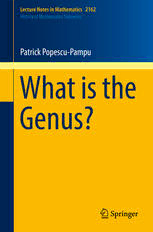
What is the Genus? PDF
Preview What is the Genus?
Lecture Notes in Mathematics 2162 History of Mathematics Subseries Patrick Popescu-Pampu What is the Genus? Lecture Notes in Mathematics 2162 Editors-in-Chief: J.-M.Morel,Cachan B.Teissier,Paris AdvisoryBoard: CamilloDeLellis,Zurich MariodiBernardo,Bristol AlessioFigalli,Zurich DavarKhoshnevisan,SaltLakeCity IoannisKontoyiannis,Athens GaborLugosi,Barcelona MarkPodolskij,Aarhus SylviaSerfaty,ParisandNewYork CatharinaStroppel,Bonn AnnaWienhard,Heidelberg Moreinformationaboutthisseriesathttp://www.springer.com/series/304 Patrick Popescu-Pampu What is the Genus? 123 PatrickPopescu-Pampu UFRdeMathématiques UniversitéLille1 Villeneuved’Ascq,France ExpandedtranslationbytheauthoroftheoriginalFrenchedition: Patrick Popescu-Pampu, Qu’est-ce que le genre?, in: Histoires de Mathématiques, Actes des Journées X-UPS 2011, Ed. Ecole Polytechnique (2012), ISBN 978-2-7302-1595-4, pp.55-198 ISSN0075-8434 ISSN1617-9692 (electronic) LectureNotesinMathematics ISBN978-3-319-42311-1 ISBN978-3-319-42312-8 (eBook) DOI10.1007/978-3-319-42312-8 LibraryofCongressControlNumber:2016950015 MathematicsSubjectClassification(2010):01A05,14-03,30-03,55-03 ©SpringerInternationalPublishingSwitzerland2016 Thisworkissubjecttocopyright.AllrightsarereservedbythePublisher,whetherthewholeorpartof thematerialisconcerned,specificallytherightsoftranslation,reprinting,reuseofillustrations,recitation, broadcasting,reproductiononmicrofilmsorinanyotherphysicalway,andtransmissionorinformation storageandretrieval,electronicadaptation,computersoftware,orbysimilarordissimilarmethodology nowknownorhereafterdeveloped. Theuseofgeneraldescriptivenames,registerednames,trademarks,servicemarks,etc.inthispublication doesnotimply,evenintheabsenceofaspecificstatement,thatsuchnamesareexemptfromtherelevant protectivelawsandregulationsandthereforefreeforgeneraluse. Thepublisher,theauthorsandtheeditorsaresafetoassumethattheadviceandinformationinthisbook arebelievedtobetrueandaccurateatthedateofpublication.Neitherthepublishernortheauthorsor theeditorsgiveawarranty,expressorimplied,withrespecttothematerialcontainedhereinorforany errorsoromissionsthatmayhavebeenmade. Printedonacid-freepaper ThisSpringerimprintispublishedbySpringerNature TheregisteredcompanyisSpringerInternationalPublishingAGSwitzerland To Ghislaine,FantinandLine Preface to the English Translation In France, some students follow special curricula during the first 2 years of their superior formation, in “classes préparatoires.” There, an intensive training is organized for the entrance examinations to teaching institutions in science or engineering,theso-called“grandesécoles.” Every May, one of those “great schools,” École Polytechnique, organizes a 2- day mathematical conference with lectures given by professional mathematicians and addressed to mathematics teachers of “classes préparatoires.” Each year, the organizerschooseaspecialtheme. In the beginning of 2011, Pascale Harinck, Alain Plagne, and Claude Sabbah invitedme togiveoneofthoselectures.The themeofthatyearwas “Histoiresde Mathématiques.”ThistitlehasanambiguityinFrench,asitmaybeunderstoodboth as “History of Mathematics” and “Stories about Mathematics.” I chose to respect thisambiguitybyspeakingaboutthehistoryofmathematicsandatthesame time bytellingastory.ThesubjectofthisstorywassuggestedtomebyClaudeSabbah inhisinvitationmessage:“thenotionofgenusinalgebraicgeometry,arithmeticand thetheoryofsingularities.” I accepted because I saw in the genus one of the most fascinating notions of mathematics,initsrichmetamorphosesandinthewealthofphenomenaitinvolves. Itmaybeseenastheprototypeoftheconceptofaninvariantingeometry.Preparing the talk and writing the accompanyingtext for the proceedingsto be published at theendofthesameyearappearedtomeasanexcellentopportunitytolearnmore aboutthedevelopmentofthisnotion. Atthatmoment,Icouldnothaveimaginedthatnavigatingthroughtheoriginal writings of the discovererswould lead me to a book-lengthtext! In it, I followed severalof the evolutionarybranchesof the notion of genus,from its prehistoryin problemsofintegration,throughthecasesofalgebraiccurvesandtheirassociated Riemannsurfaces,thenofalgebraicsurfaces,intohigherdimensions.Ihadofcourse toomitmanyaspectsofthisincrediblyversatileconcept,butIhopethatthereader whofollowsmewillcontinuethisexplorationaccordingtoherorhisowntaste. I am not a professional historian of mathematics, but I love to understand the developmentof mathematical ideas from this perspective. Such an understanding vii viii PrefacetotheEnglishTranslation seems essential to me both for doing research and for communicating with other mathematiciansorwithstudents. ThisbookisaslightlyexpandedtranslationoftheoriginalFrenchversion[155]. I corrected a few errors; I reformulated several vague sentences; I added some explanations,figures, or references;and I reorganizedthe index. I also added two new chapters, one about Whitney’s work on sphere bundles and another one on Harnack’sformularelatingthegenusofaRiemannsurfacedefinedovertherealsto thenumberofconnectedcomponentsofitsreallocus. Acknowledgments Itookgreatadvantagefromtheteamworkleadingtothebook [52],especiallytheensuingcontactwithwritingsofthenineteenthcentury.Iwantto thankallmyco-authors.IamalsokeentothankClémentCaubel,YoussefHantout, AndreasHöring,WalterNeumann,ClaudeSabbah,MichelSerfati,OlivierSerman, andBernardTeissierfortheirhelp,theirremarks,andtheiradvice.Iamparticularly indebtedtoMariaAngelicaCuetoforherverycarefulreadingofthefirstversionof myEnglishtranslationandheradviceforimprovingit.Iamalsoverygratefultothe languageeditorBarnabySheppard.Finally,IwanttothankwarmlyUteMcCroryfor havingraisedtheideatopublishthistextasabookintheHistoryofMathsubseries ofSpringerLectureNotesinMathematics. Villeneuved’Ascq,France PatrickPopescu-Pampu Contents 1 The(cid:2)"K(cid:3)o& AccordingtoAristotle........................................ 1 PartI AlgebraicCurves 2 DescartesandtheNewWorldofCurves................................. 5 3 NewtonandtheClassificationofCurves................................. 7 4 WhenIntegralsHideCurves.............................................. 9 5 JakobBernoulliandtheConstructionofCurves ....................... 11 6 FagnanoandtheLemniscate.............................................. 15 7 EulerandtheAdditionofLemniscaticIntegrals ....................... 17 8 LegendreandEllipticFunctions.......................................... 19 9 AbelandtheNewTranscendentalFunctions ........................... 21 10 AProofbyAbel ............................................................ 23 11 Abel’sMotivations.......................................................... 25 12 CauchyandtheIntegrationPaths........................................ 27 13 PuiseuxandthePermutationsofRoots.................................. 31 14 RiemannandtheCuttingofSurfaces ................................... 35 15 RiemannandtheBirationalInvarianceofGenus ...................... 41 16 TheRiemann–RochTheorem............................................. 43 17 AReinterpretationofAbel’sWorks...................................... 45 18 JordanandtheTopologicalClassification .............................. 51 19 CliffordandtheNumberofHoles ....................................... 53 ix
